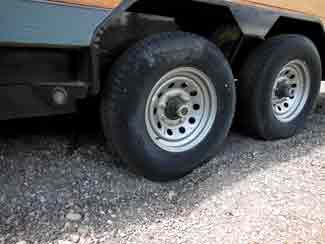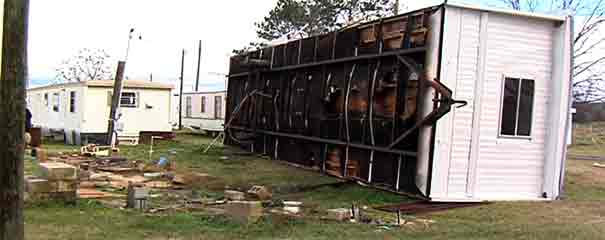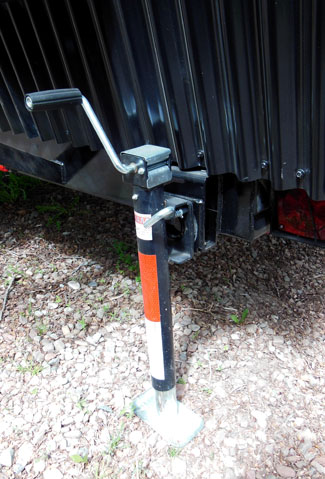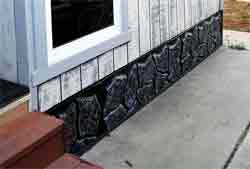Tiny House Foundations
You would think a tiny house on wheels would not need a foundation
Your insurance company, mortgage company, and county building codes might think otherwise.
After all, leveling an RV at a campground site for the weekend is pretty basic. You might think that your tiny house is the same. Just put the leveling jacks on the corners and you’re done. This is fine for the short term. However, data shows that tiny homes are actually only moved an average of four times in their lifetime. Consider a tiny house foundation for safety.

Strong winds can tip over a tiny home.
Because “Tiny Homes On Wheels” occupy a grey area within the building codes, you could be forced to comply with RV building codes, home building codes, or both. These requirements will be dictated by your local code enforcement officials, your mortgage company (if you have one), and your insurance company. Mortgage companies usually require your structure to be attached to a foundation and the wheels removed so they know where their investment is. Sometimes they even require the installation of a GPS device for the same reason. It is also a great theft deterrent.
Tiny homes are small enough that the heaving caused by heating, cooling, and moisture content of the ground is usually not a concern. Of greater concern are high winds toppling the structure. This has long been a known issue in mobile home parks. They almost always require tie-downs.
Appendix E of the 2015 IRC addresses the issue of securing a “manufactured” home to a foundation.
Tie-downs
Tie-downs can be as simple as a metal rod twisted into the ground with a cable connected to the trailer frame. The better ones will run a metal strap all the way over the top of the structure. If your home has been constructed with steel framing, you only need to connect the tie downs to the frame. If framing with wood, you can insert metal strapping inside the walls to create a safe, invisible tie-down strap.
See more details about tiny house tie-down kits on this page of Tiny Life Consulting website: Preventing Tiny House Blow-over
Install leveling jacks and remove the wheels
Leveling jacks come in many types. This Fulton Side Wind Trailer Jack has a 21″ extension and can stay bolted to the trailer while traveling. It swivels 90° when not in use.
For a more permanent foundation, cement blocks can be used. Add small pieces of wood between cement block and trailer for finer adjustments.
I strongly recommend covering the wheels from direct sunlight as much as possible to prevent deterioration. Sun damage can happen very quickly, making the tires unsafe and prone to blowouts. Relieving the weight off the tires and axles can prolong the life of tires and prevent axle wear.
Tiny house foundation sketch
Here is a link to a sketch of a type of tiny home foundation sketch I recommend. See sketch below. This foundation has pilings that go below the frost line to prevent heaving. It also offers a stable platform for the wheels, and pillars so they will not sink into the dirt over time.
The stabilizer jacks in the diagram can be replaced with concrete blocks with wood shims on top.
Leveling Your Tiny Home
James Edwards, who builds concrete pads for machinery told me, “Trailers are specifically built to support certain distributed loads, and each model is different. You can easily bend a trailer frame by lifting in the wrong places. Adding jacks to a weighted trailer is lifting. You do not want to “unload your tires”. This means do not take the weight off of the axles: they are designed to transfer the weight to the ground. You can support and balance with jacks, but don’t lift the wheels. You can block under your axles and remove the tires to save them. Just keep your weight concentrated at the axle/spring mount location.
Also see my page on Permanent Foundations for HUD approved suggestions.

A “professionally” made gravel trailer pad settled over a foot under one tire over the winter.
Benefits of a Full-Size Concrete Pad
Instead of 18″ wide tracks, consider pouring a full width (8 feet) concrete pad.
- Make the pad eight to twelve feet longer than your tiny home, and use the extra length as a nice patio space.
- Concrete will give your “skirting” a stable foundation to attach to. Add doors and the underside of your tiny home becomes nice clean storage space. I set off a bug bomb once a year, in the spring, to kill the spiders.
- Clean storage area. With hatches added to the skirting, the area underneath the tiny home becomes a clean, hidden storage area.
Permanent Tiny House Foundations
See our separate page: Permanent Tiny House Foundations for more information.
HUD Documents
If you are interested, here are links to a HUD document concerning manufactured homes that can give you valuable insights into the proper methods for a tiny house foundation.
PERMANENT FOUNDATIONS GUIDE FOR MANUFACTURED HOUSING
As of this writing, HUD does not regulate tiny homes. However, this is changing by the day. Committees have been formed and amendments have been written to the building codes that will soon be agreed upon and passed onto law. For more details on tiny house zoning laws, visit these pages of the Tiny Life Consulting website: Codes and Zoning, Building and Living Legally In Tiny Homes.
Tiny House Skirting
Skirting not only adds a neat appearance to your tiny home; it also functions as added insulation in winter. Keeping the wind from getting underneath helps protect against blow-over, as well as water pipes from freezing.
There are premade kits that offer a variety of looks, but you can also make your own like my friend Jennifer Fuist at Tiny Dreamer did.
For more information about skirting see this page: Skirting for Tiny Houses, Travel Trailers, and RVs
And this page: RV Winter Living, How to Prepare
Featured image at top of page: A mobile home in southern Baker County, GA, that was flipped by estimated 70- to 75-mph straight line winds on the evening of 18 February 2012. Photo courtesy of WALB-TV.





